An Unsupervised Learning Approach for Analyzing Unsafe Pilot Operations Based on Flight Data
Abstract
:1. Introduction
- To the best of our knowledge, this work is the first systematic study analyzing pilots’ unsafe forward stick operations based on a large volume of flight data. The findings from this work can be used by airlines to design more targeted pilot training programs in the future, which has great practical importance for aviation safety.
- The key features are extracted based on the experience of flight experts, and then the K-means clustering method is used to uncover the reasons for unsafe pilot stick operations. A benefit to the flight expert experience, the obtained results show good explainability.
- Extensive experiments are conducted to investigate how different classes of the adverse event are correlated with different airlines, airports, and pilots. The results provide new insights into the understanding of unsafe pilot operations during landing.
2. Related Work
2.1. Safety Incident Prediction
2.2. Flight Safety Analysis
2.3. Application of K-Means Clustering
2.4. Summary of Existing Studies
3. Methodology
3.1. Problem Statement
3.2. Data Preprocessing and Feature Selection
3.3. K-Means Clustering
4. Experiment
4.1. Dataset
4.2. Model Hyperparameters
4.3. Experiment Results and Interpretation
- The first type (headwind influence): This type is represented by yellow lines. The characteristic of this type is that its headwind parameter values are significantly higher than other types. When the aircraft encounters heavy headwinds during the flare, the wind will have an effect of increasing the aircraft pitch angle in a short period of time. If the pilot is not prepared for this situation, then he may apply the forward stick operation to counteract the wind effect. For this type, the pilot should pay significant attention to the wind conditions during the landing stage.
- The second type (high pitch influence): This type is represented by red lines. The characteristic of this type is that the cumulative value of the pitch angle change (PITCH_C) and maximum pitch angle of the aircraft (PITCH_M) is very large before the pilot applies the forward stick inputs. Meanwhile, the height is relatively high, and the influence from the wind is insignificant. So, it can be concluded that the aircraft has endured a continuous increasing in the pitch angle, and its pitch angle finally becomes too large. This is usually caused by the pilot’s unawareness of the aircraft status and attitude, i.e., keeping a stable pitch angle with a relatively small vertical speed. As a result, the pilot applies the stick forward operation to directly reduce the pitch angle of the aircraft in order to avoid the tail strike risk. For this type, the pilot should be aware of the pitch attitude of the aircraft, especially when it is close to the ground. If the pitch angle becomes too high and it was not likely to stabilize in time, then the pilot should initiate a go-around.
- The third type (long flare influence): This type is represented by blue lines, from which we observe that the height parameter almost keeps unchanged at a very low attitude during the one second. In this type, although there are some tail winds (WIND < 0), its impact is insignificant. The result indicates that the aircraft keeps flaring at a relatively low height. Most frequently, this is caused by the pilots excessive applying of back stick inputs, which will quickly reduce the aircraft vertical speed. When the aircraft keeps flaring at a relatively low height due to the pilot’s excessive reduction in the vertical speed, then they may further perform the forward stick operation to make the aircraft touch the ground as soon as possible so as to avoid the runway overrun [21,32] risk. For this type, the pilot should be aware of the vertical speed of the aircraft and avoid reducing the vertical speed too much before entering the flare.
- The fourth type: This type is represented by green lines. This type of flight does not show a significant low height or large pitch angle, which means the aircraft was not enduring an abnormal situation. For this type, the pilot should get more flight training to improve their landing skills.
4.4. Further Analysis on Impacting Factors
5. Conclusions
Author Contributions
Funding
Institutional Review Board Statement
Informed Consent Statement
Data Availability Statement
Acknowledgments
Conflicts of Interest
Abbreviations
| MDPI | Multidisciplinary Digital Publishing Institute |
| QAR | Quick Access Recorder |
| EASA | European Union Aviation Safety Agency |
| FCTM | Flight Crew Techniques Manual |
| DFDR | Digital Flight Data Recorder |
| LSTM | Long Short-Term Memory |
| GRU | Gated Recurrent Unit |
| SOP | Standard Operating Procedure |
References
- Şenol, M.B. Evaluation and prioritization of technical and operational airworthiness factors for flight safety. Aircr. Eng. Aerosp. Technol. 2020, 92, 1049–1061. [Google Scholar] [CrossRef]
- Reiche, C.; Cohen, A.P.; Fernando, C. An initial assessment of the potential weather barriers of urban air mobility. IEEE Trans. Intell. Transp. Syst. 2021, 22, 6018–6027. [Google Scholar] [CrossRef]
- Shao, Q.; Zhou, Y.; Zhu, P. Spatiotemporal analysis of environmental factors on the birdstrike risk in high plateau airport with multi-scale research. Sustainability 2020, 12, 9357. [Google Scholar] [CrossRef]
- Li, X.; Shang, J.; Zheng, L.; Wang, Q.; Sun, H.; Qi, L. CurveCluster+: Curve Clustering for Hard Landing Pattern Recognition and Risk Evaluation Based on Flight Data. IEEE Trans. Intell. Transp. Syst. 2022, 23, 12811–12821. [Google Scholar] [CrossRef]
- Kong, Y.; Zhang, X.; Mahadevan, S. Bayesian Deep Learning for Aircraft Hard Landing Safety Assessment. IEEE Trans. Intell. Transp. Syst. 2022, 23, 17062–17076. [Google Scholar] [CrossRef]
- Rozelle, R.; Lacagnina, M.; Rosenkrans, W.; Werfelman, L.; Darby, R. Stabilized approach and flare are keys to avoiding hard landings. Flight Saf. Dig. 2004, 23, 1–25. [Google Scholar]
- Wang, L.; Ren, Y.; Wu, C. Effects of flare operation on landing safety: A study based on ANOVA of real flight data. Saf. Sci. 2018, 102, 14–25. [Google Scholar] [CrossRef]
- Hu, C.; Zhou, S.H.; Xie, Y.; Chang, W.B. The study on hard landing prediction model with optimized parameter SVM method. In Proceedings of the 2016 35th Chinese Control Conference (CCC), Chengdu, China, 27–29 July 2016; pp. 4283–4287. [Google Scholar]
- Tong, C.; Yin, X.; Li, J.; Zhu, T.; Lv, R.; Sun, L.; Rodrigues, J.J. An innovative deep architecture for aircraft hard landing prediction based on time-series sensor data. Appl. Soft Comput. 2018, 73, 344–349. [Google Scholar] [CrossRef]
- Wang, L.; Wu, C.; Sun, R. An analysis of flight Quick Access Recorder (QAR) data and its applications in preventing landing incidents. Reliab. Eng. Syst. Saf. 2014, 127, 86–96. [Google Scholar] [CrossRef]
- Haverdings, H.; Chan, P.W. Quick access recorder data analysis software for windshear and turbulence studies. J. Aircr. 2010, 47, 1443–1447. [Google Scholar] [CrossRef]
- Huang, R.; Sun, H.; Wu, C.; Wang, C.; Lu, B. Estimating eddy dissipation rate with QAR flight big data. Appl. Sci. 2019, 9, 5192. [Google Scholar] [CrossRef] [Green Version]
- Wu, E.Q.; Tang, Z.R.; Hu, R.; Zhang, M.; Li, G.J.; Zhu, L.M.; Zhou, G.R. Flight situation recognition under different weather conditions. IEEE Trans. Aerosp. Electron. Syst. 2021, 57, 1753–1767. [Google Scholar] [CrossRef]
- Guo, Y.; Sun, Y.; He, Y.; Du, F.; Su, S.; Peng, C. A Data-driven Integrated Safety Risk Warning Model based on Deep Learning for Civil Aircraft. IEEE Trans. Aerosp. Electron. Syst. 2022, 1–14. [Google Scholar] [CrossRef]
- Hamerly, G.; Elkan, C. Learning the k in k-means. Adv. Neural Inf. Process. Syst. 2004, 16, 281–288. [Google Scholar]
- Moshkovitz, M.; Dasgupta, S.; Rashtchian, C.; Frost, N. Explainable k-means and k-medians clustering. In Proceedings of the International Conference on Machine Learning. PMLR, Virtual, 13–18 July 2020; pp. 7055–7065. [Google Scholar]
- Haipeng, C.; Ping, S.; Shengguo, H. Study of aircraft hard landing diagnosis based on nerual network. Comput. Meas. Control 2008, 16, 906–908. [Google Scholar]
- Qiao, X.; Chang, W.; Zhou, S.; Lu, X. A prediction model of hard landing based on RBF neural network with K-means clustering algorithm. In Proceedings of the 2016 IEEE International Conference on Industrial Engineering and Engineering Management (IEEM), Bali, Indonesia, 4–7 December 2016; pp. 462–465. [Google Scholar]
- Tong, C.; Yin, X.; Wang, S.; Zheng, Z. A novel deep learning method for aircraft landing speed prediction based on cloud-based sensor data. Future Gener. Comput. Syst. 2018, 88, 552–558. [Google Scholar] [CrossRef]
- Chen, H.; Shang, J.; Zhao, X.; Li, X.; Zheng, L.; Chen, F. A deep learning method for landing pitch prediction based on flight data. In Proceedings of the 2020 IEEE 2nd International Conference on Civil Aviation Safety and Information Technology (ICCASIT), Weihai, China, 14–16 October 2020; pp. 199–204. [Google Scholar]
- Kang, Z.; Shang, J.; Feng, Y.; Zheng, L.; Liu, D.; Qiang, B.; Wei, R. A deep sequence-to-sequence method for aircraft landing speed prediction based on QAR data. In Proceedings of the International Conference on Web Information Systems Engineering, Amsterdam, The Netherlands, 20–24 October 2020; pp. 516–530. [Google Scholar]
- Wang, L.; Wu, C.; Sun, R. Pilot operating characteristics analysis of long landing based on flight QAR data. In Proceedings of the International Conference on Engineering Psychology and Cognitive Ergonomics, Las Vegas, NV, USA, 21–26 July 2013; pp. 157–166. [Google Scholar]
- Kang, Z.; Shang, J.; Feng, Y.; Zheng, L.; Wang, Q.; Sun, H.; Qiang, B.; Liu, Z. A deep sequence-to-sequence method for accurate long landing prediction based on flight data. IET Intell. Transp. Syst. 2021, 15, 1028–1042. [Google Scholar] [CrossRef]
- Qi, M.; Shao, X.; Chi, H. Flight operations risk diagnosis method on quick-access-record exceedance. J. Beijing Univ. Aeronaut. Astronaut. 2011, 37, 1207–1210. [Google Scholar]
- Wang, W.; Zhang, T.; Wang, L. Markov chain-based flight operations risk analysis. In Proceedings of the 2017 13th International Conference on Natural Computation, Fuzzy Systems and Knowledge Discovery (ICNC-FSKD), Guilin, China, 29–31 July 2017; pp. 2441–2445. [Google Scholar]
- Liu, S.; Zhang, Y.; Chen, J. A system for evaluating pilot performance based on flight data. In Proceedings of the International Conference on Engineering Psychology and Cognitive Ergonomics, Las Vegas, NV, USA, 15 July 2018; pp. 605–614. [Google Scholar]
- Li, X.; Shang, J.; Zheng, L.; Liu, D.; Qi, L.; Liu, L. CurveCluster: Automated recognition of hard landing patterns based on QAR curve clustering. In Proceedings of the 2019 IEEE SmartWorld, Ubiquitous Intelligence & Computing, Advanced & Trusted Computing, Scalable Computing & Communications, Cloud & Big Data Computing, Internet of People and Smart City Innovation (SmartWorld/SCALCOM/UIC/ATC/CBDCom/IOP/SCI), Leicester, UK, 19–23 August 2019; pp. 602–609. [Google Scholar]
- Wang, L.; Zhang, J.; Sun, H.; Ren, Y. Risk cognition variables and flight exceedance behaviors of airline transport pilots. In Proceedings of the International Conference on Engineering Psychology and Cognitive Ergonomics, Las Vegas, NV, USA, 15–20 July 2018; pp. 725–737. [Google Scholar]
- Lv, H.; Yu, J.; Zhu, T. A novel method of overrun risk measurement and assessment using large scale QAR data. In Proceedings of the 2018 IEEE Fourth International Conference on Big Data Computing Service and Applications (BigDataService), Bamberg, Germany, 26–29 March 2018; pp. 213–220. [Google Scholar]
- Janakiraman, V.M. Explaining aviation safety incidents using deep temporal multiple instance learning. In Proceedings of the 24th ACM SIGKDD International Conference on Knowledge Discovery & Data Mining, London, UK, 19–23 August 2018; pp. 406–415. [Google Scholar]
- Janakiraman, V.M.; Matthews, B.; Oza, N. Finding precursors to anomalous drop in airspeed during a flight’s takeoff. In Proceedings of the 23rd ACM SIGKDD International Conference on Knowledge Discovery and Data Mining, Halifax, NS, Canada, 13–17 August 2017; pp. 1843–1852. [Google Scholar]
- Ayra, E.S.; Ríos Insua, D.; Cano, J. Bayesian network for managing runway overruns in aviation safety. J. Aerosp. Inf. Syst. 2019, 16, 546–558. [Google Scholar] [CrossRef]
- Ran, X.; Zhou, X.; Lei, M.; Tepsan, W.; Deng, W. A Novel K-Means Clustering Algorithm with a Noise Algorithm for Capturing Urban Hotspots. Appl. Sci. 2021, 11, 11202. [Google Scholar] [CrossRef]
- Gu, C.; Qi, J.; Zhao, Y.; Yin, W.; Zhu, S. Estimation of the Mixed Layer Depth in the Indian Ocean from Surface Parameters: A Clustering-Neural Network Method. Sensors 2022, 22, 5600. [Google Scholar] [CrossRef] [PubMed]
- Abernathy, A.; Celebi, M.E. The incremental online k-means clustering algorithm and its application to color quantization. Expert Syst. Appl. 2022, 207, 117927. [Google Scholar] [CrossRef]
- Estupiñán Ricardo, J.; Domínguez Menéndez, J.J.; Barcos Arias, I.F.; Macías Bermúdez, J.M.; Moreno Lemus, N. Neutrosophic K-means for the analysis of earthquake data in Ecuador. Neutrosophic Sets Syst. 2021, 44, 29. [Google Scholar]
- Hutagalung, J.; Ginantra, N.L.W.S.R.; Bhawika, G.W.; Parwita, W.G.S.; Wanto, A.; Panjaitan, P.D. Covid-19 cases and deaths in southeast Asia clustering using k-means algorithm. J. Phys. Conf. Ser. 2021, 1783, 012027. [Google Scholar] [CrossRef]
- Ikotun, A.M.; Almutari, M.S.; Ezugwu, A.E. K-Means-Based Nature-Inspired Metaheuristic Algorithms for Automatic Data Clustering Problems: Recent Advances and Future Directions. Appl. Sci. 2021, 11, 11246. [Google Scholar] [CrossRef]
- Schmidt, L.V. Introduction to Aircraft Flight Dynamics; AIAA: Reston, VA, USA, 1998. [Google Scholar]
- Hamerly, G.; Elkan, C. Learning the k in k-means. In Proceedings of the Advances in Neural Information Processing Systems; Thrun, S., Saul, L., Schölkopf, B., Eds.; MIT Press: Cambridge, MA, USA, 2003; Volume 16. [Google Scholar]
- Zhao, H.; Zhang, C. An online-learning-based evolutionary many-objective algorithm. Inf. Sci. 2020, 509, 1–21. [Google Scholar] [CrossRef]
- Dulebenets, M.A. An Adaptive Polyploid Memetic Algorithm for scheduling trucks at a cross-docking terminal. Inf. Sci. 2021, 565, 390–421. [Google Scholar] [CrossRef]
- Kavoosi, M.; Dulebenets, M.A.; Abioye, O.; Pasha, J.; Theophilus, O.; Wang, H.; Kampmann, R.; Mikijeljević, M. Berth scheduling at marine container terminals: A universal island-based metaheuristic approach. Marit. Bus. Rev. 2019, 5, 30–66. [Google Scholar] [CrossRef]
- Pasha, J.; Nwodu, A.L.; Fathollahi-Fard, A.M.; Tian, G.; Li, Z.; Wang, H.; Dulebenets, M.A. Exact and metaheuristic algorithms for the vehicle routing problem with a factory-in-a-box in multi-objective settings. Adv. Eng. Inform. 2022, 52, 101623. [Google Scholar] [CrossRef]
- Kavoosi, M.; Dulebenets, M.A.; Abioye, O.F.; Pasha, J.; Wang, H.; Chi, H. An augmented self-adaptive parameter control in evolutionary computation: A case study for the berth scheduling problem. Adv. Eng. Inform. 2019, 42, 100972. [Google Scholar] [CrossRef]
- Rabbani, M.; Oladzad-Abbasabady, N.; Akbarian-Saravi, N. Ambulance routing in disaster response considering variable patient condition: NSGA-II and MOPSO algorithms. J. Ind. Manag. Optim. 2022, 18, 1035. [Google Scholar] [CrossRef]
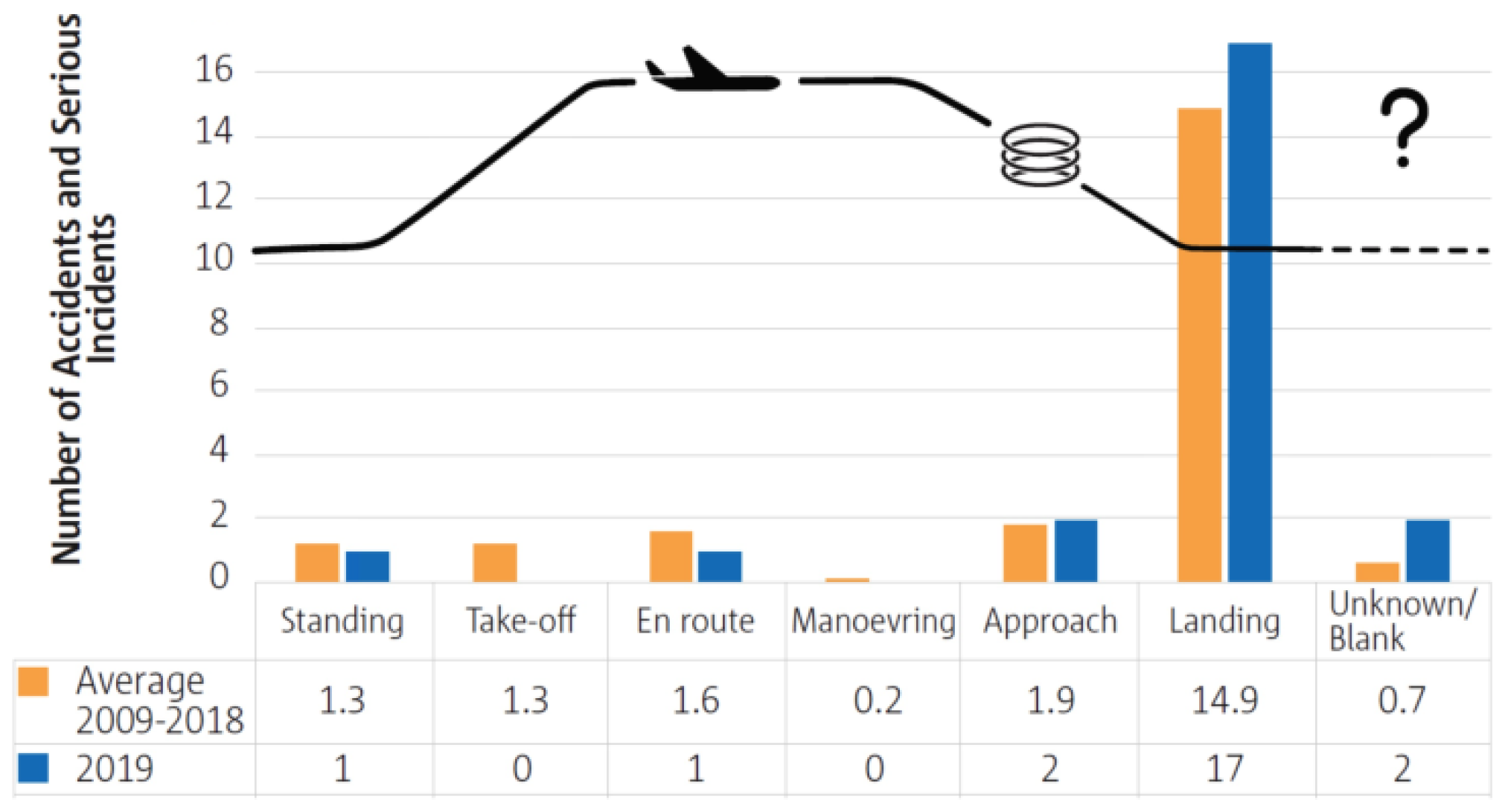

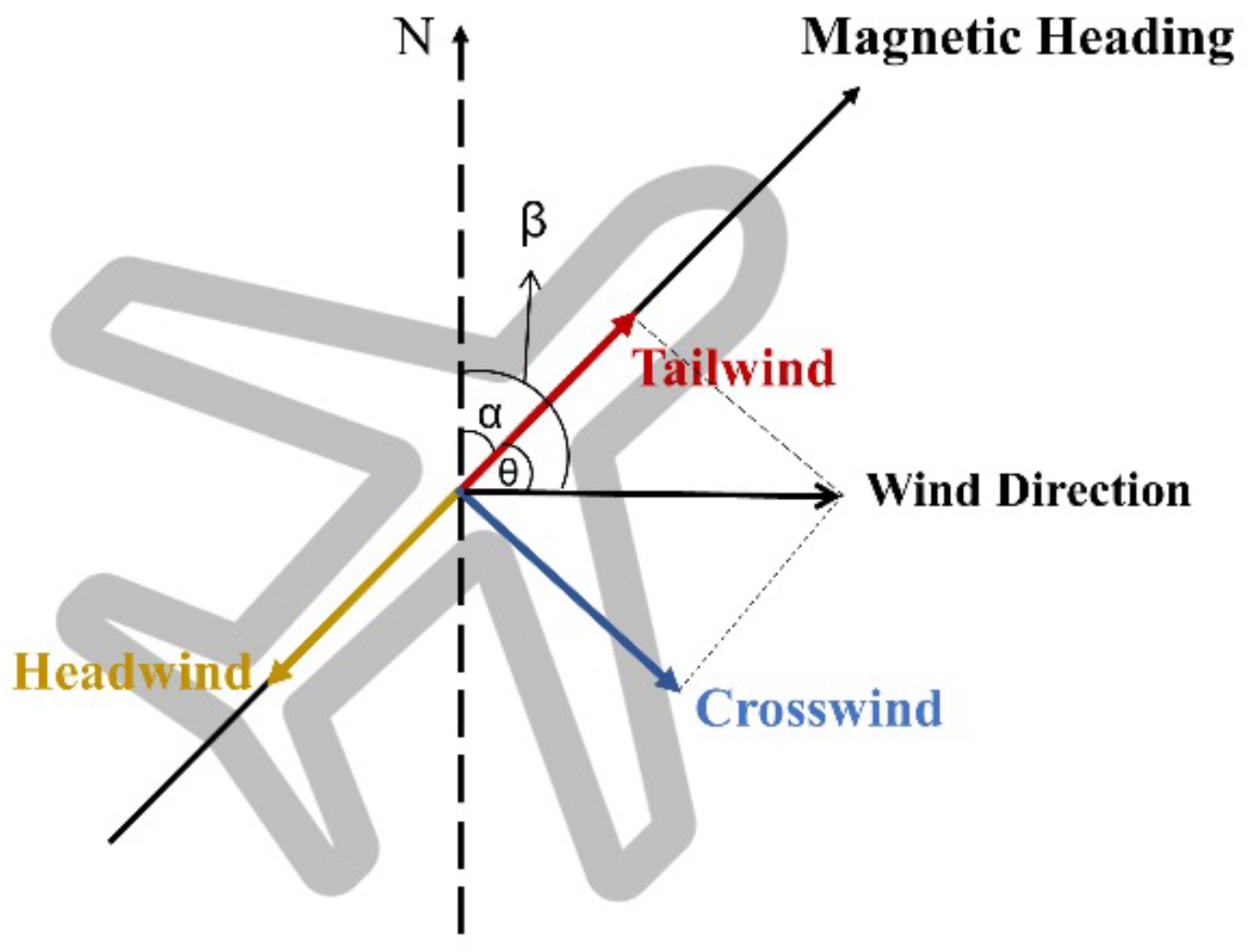
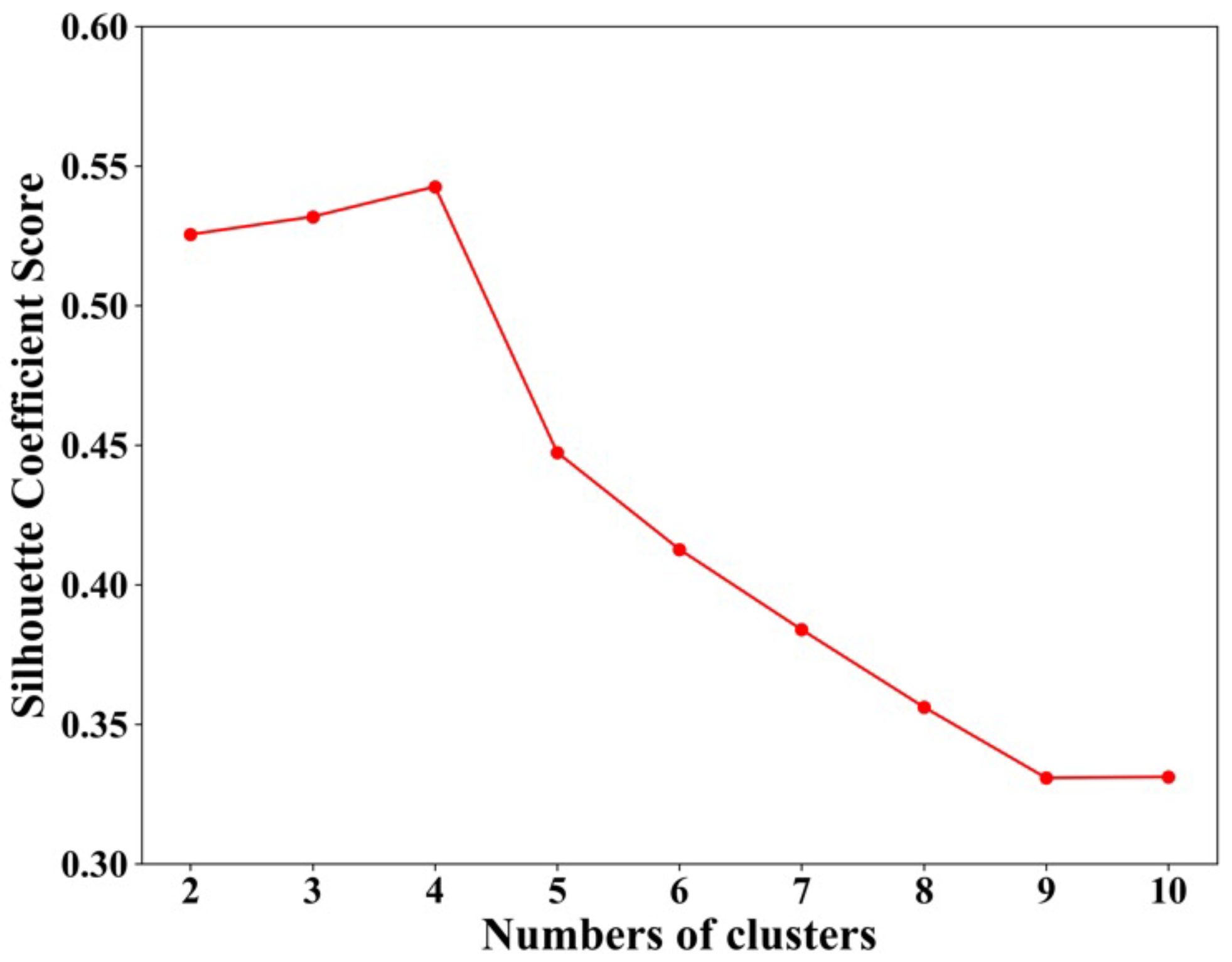

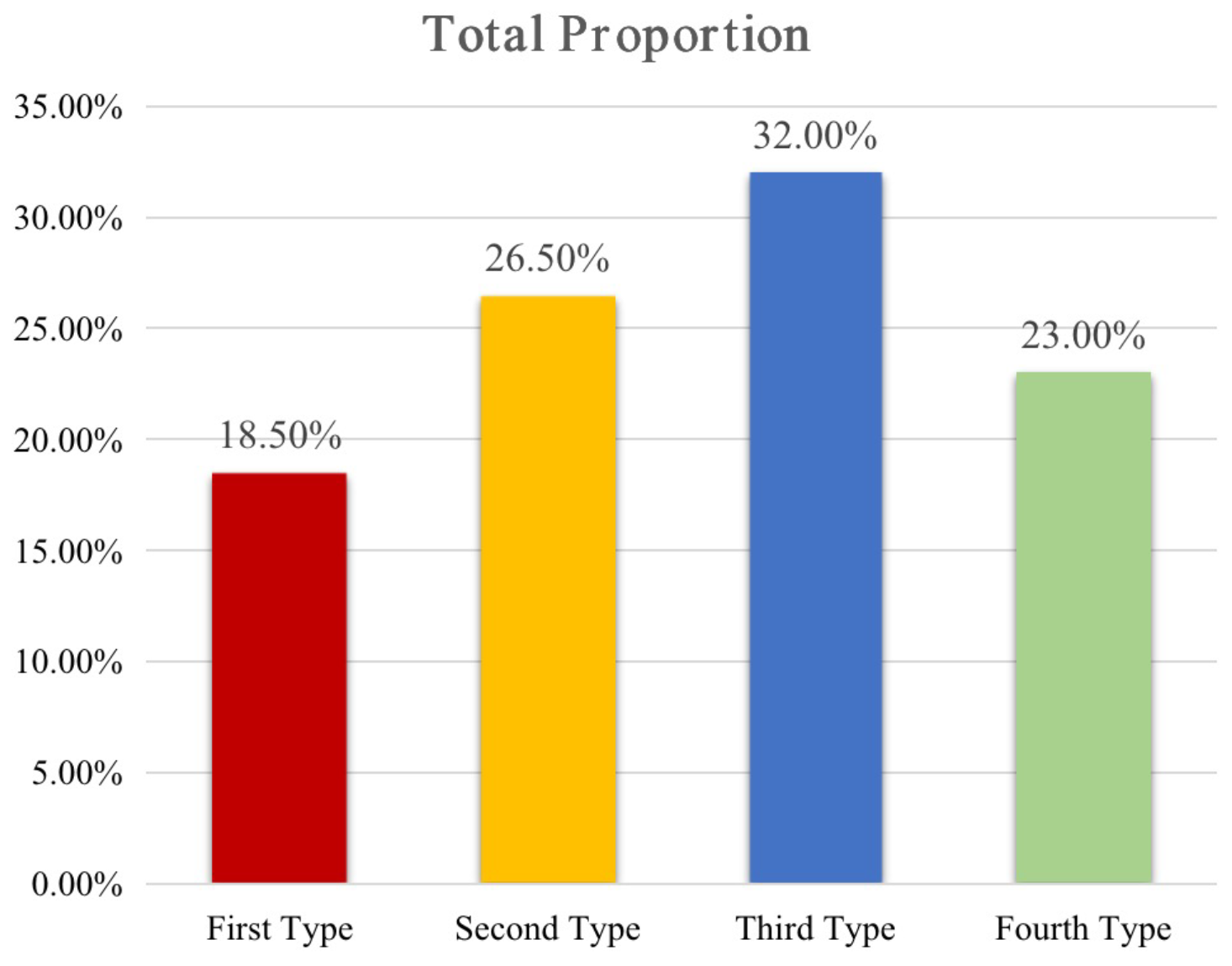

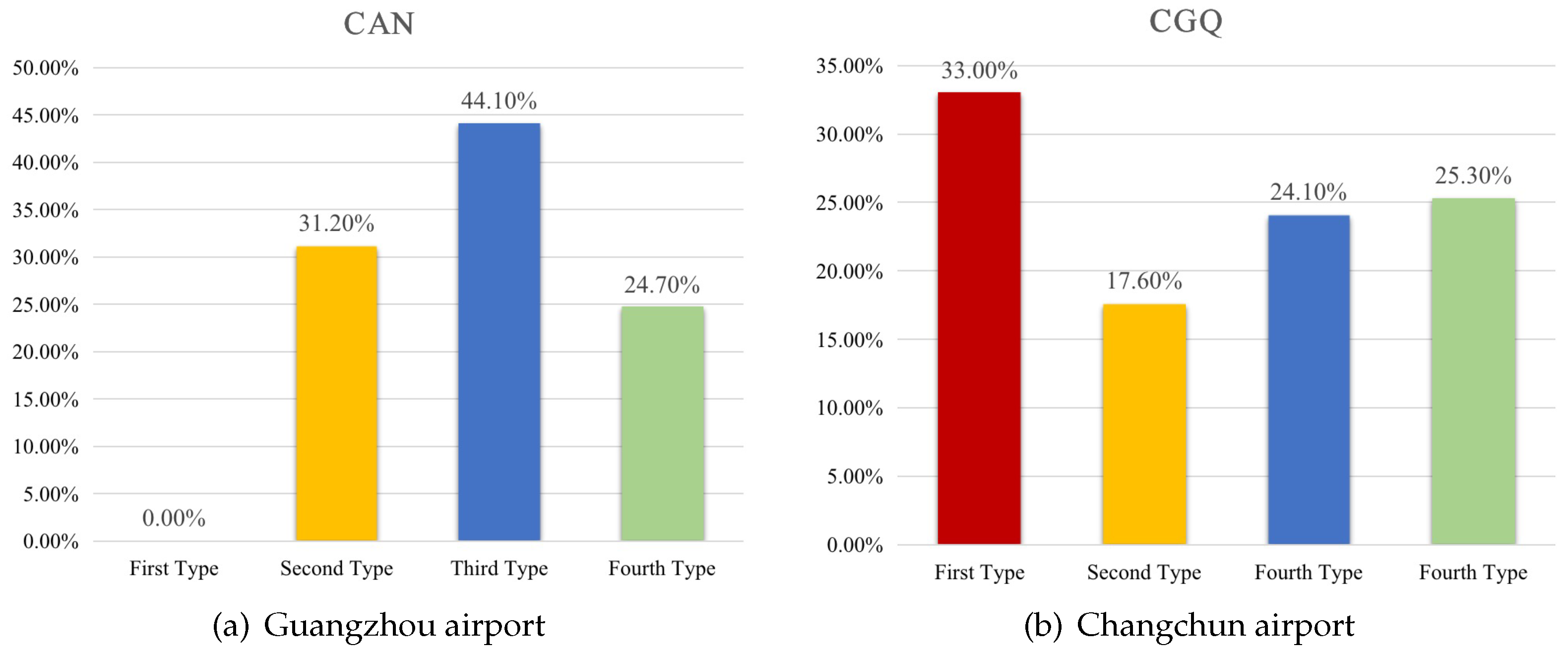

| No. | Parameter | Description | Frequency (Hz) |
|---|---|---|---|
| 1 | ALT_QNH | Altitude | 1 |
| 2 | ALT_STD | Standard altitude corrected | 1 |
| 3 | RADIO_LH | Left radio height | 4 |
| 4 | RADIO_RH | Right radio height | 4 |
| 5 | LDGL | Left landing gear state | 4 |
| 6 | LDGR | Right landing gear state | 4 |
| 7 | LDGNOS | Nose landing gear state | 4 |
| 8 | IAS | Indicated airspeed | 1 |
| 9 | VAPP | Landing reference speed | 1 |
| 10 | GS | Ground speed | 1 |
| 11 | VRTG | Vertical acceleration | 8 |
| 12 | IVV | Vertical speed | 1 |
| 13 | PITCH | Pitch angle | 4 |
| 14 | PITCH_CPT | Captain pitch control | 8 |
| 15 | PITCH_FO | Deputy captain pitch control | 8 |
| 16 | GW | Aircraft gross weight | 1 |
| 17 | ROLL | Roll angel | 2 |
| 18 | ROLL_CPT | Captain roll control | 8 |
| 19 | ROLL_FO | Deputy captain roll control | 8 |
| 20 | HEAD_MAG | Magnetic heading direction | 1 |
| 21 | WIN_DIR | Wind direction | 1 |
| 22 | WIN_SPD | Wind speed | 1 |
| 23 | RUDD | Rudder position | 2 |
| 24 | N11 | Engine 1 speed ratio | 1 |
| 25 | N12 | Engine 2 speed ratio | 1 |
| 26 | TLA1 | Throttle lever 1 position | 1 |
| 27 | TLA2 | Throttle lever 2 position | 1 |
| 28 | FLAP_PL | Left flap actual angle | 1 |
| 29 | FLAP_PR | Right flap actual angle | 1 |
| 30 | DME1 | DME 1 distance | 1 |
| 31 | DME2 | DME 2 distance | 1 |
| Feature | Description |
|---|---|
| PITCH_C | The cumulative change in pitch angle |
| PITCH_M | The maximum pitch angle in the flare phase |
| WIND | The average headwind encountered by the aircraft |
| H1, H2, H3, H4 | Four consecutive height values in one second |
Publisher’s Note: MDPI stays neutral with regard to jurisdictional claims in published maps and institutional affiliations. |
© 2022 by the authors. Licensee MDPI, Basel, Switzerland. This article is an open access article distributed under the terms and conditions of the Creative Commons Attribution (CC BY) license (https://creativecommons.org/licenses/by/4.0/).
Share and Cite
Li, X.; Qian, Y.; Chen, H.; Zheng, L.; Wang, Q.; Shang, J. An Unsupervised Learning Approach for Analyzing Unsafe Pilot Operations Based on Flight Data. Appl. Sci. 2022, 12, 12789. https://doi.org/10.3390/app122412789
Li X, Qian Y, Chen H, Zheng L, Wang Q, Shang J. An Unsupervised Learning Approach for Analyzing Unsafe Pilot Operations Based on Flight Data. Applied Sciences. 2022; 12(24):12789. https://doi.org/10.3390/app122412789
Chicago/Turabian StyleLi, Xiuyi, Yu Qian, Hongnian Chen, Linjiang Zheng, Qixing Wang, and Jiaxing Shang. 2022. "An Unsupervised Learning Approach for Analyzing Unsafe Pilot Operations Based on Flight Data" Applied Sciences 12, no. 24: 12789. https://doi.org/10.3390/app122412789
APA StyleLi, X., Qian, Y., Chen, H., Zheng, L., Wang, Q., & Shang, J. (2022). An Unsupervised Learning Approach for Analyzing Unsafe Pilot Operations Based on Flight Data. Applied Sciences, 12(24), 12789. https://doi.org/10.3390/app122412789







